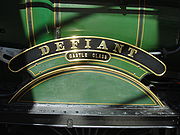
GWR 4073 Class 5080 Defiant
Encyclopedia


Ogmore Castle
Ogmore Castle is located near the village of Ogmore-by-Sea, south of the town of Bridgend in Glamorgan, South Wales. It is situated on the south bank of the River Ewenny and the east bank of the River Ogmore. Cowbridge is nearby. Its construction might have begun in 1106...
in May 1939 at Swindon Works
Swindon Works
Swindon railway works were built by the Great Western Railway in 1841 in Swindon in the English county of Wiltshire.-History:In 1835 Parliament approved the construction of a railway between London and Bristol. Its Chief Engineer was Isambard Kingdom Brunel.From 1836, Brunel had been buying...
, the engine was one of the many popular GWR Castle Class
GWR 4073 Class
The GWR 4073 Class or Castle class locomotives are a group of 4-6-0 steam locomotives of the Great Western Railway. They were originally designed by the railway's Chief Mechanical Engineer, Charles Collett, for working the company's express passenger trains.-History:A development of the earlier...
.
After transfer to Cardiff (Canton), the engine was renamed Defiant
Boulton Paul Defiant
The Boulton Paul Defiant was a British interceptor aircraft that served with the Royal Air Force early in the Second World War. The Defiant was designed and built by Boulton Paul Aircraft as a "turret fighter", without any forward-firing guns. It was a contemporary of the Royal Navy's Blackburn Roc...
in January 1941, commemorating one of the many types of aircraft which had taken part in the Battle of Britain
Battle of Britain
The Battle of Britain is the name given to the World War II air campaign waged by the German Air Force against the United Kingdom during the summer and autumn of 1940...
. The name Ogmore Castle later rotated through sister engines 5056, 7007 and 7035.
After the arrival of Britannia class
BR standard class 7
The BR Standard Class 7, otherwise known as the Britannia Class, is a class of 4-6-2 Pacific steam locomotive designed by Robert Riddles for use by British Railways for mixed traffic duties. Fifty-five were constructed between 1951 and 1954. The design was a result of the 1948 locomotive exchanges...
Pacifics
4-6-2
4-6-2, in the Whyte notation for the classification of steam locomotives, represents the wheel arrangement of four leading wheels on two axles , six powered and coupled driving wheels on three axles, and two trailing wheels on one axle .These locomotives are also known as Pacifics...
on the Western Region of British Railways
Western Region of British Railways
The Western Region was a region of British Railways from 1948. The region ceased to be an operating unit in its own right in the 1980s and was wound up at the end of 1992...
, in 1959 it had moved to Carmarthen
Carmarthen
Carmarthen is a community in, and the county town of, Carmarthenshire, Wales. It is sited on the River Towy north of its mouth at Carmarthen Bay. In 2001, the population was 14,648....
, staying there until its final move to Llanelli
Llanelli
Llanelli , the largest town in both the county of Carmarthenshire and the preserved county of Dyfed , Wales, sits on the Loughor estuary on the West Wales coast, approximately west-north-west of Swansea and south-east of the county town, Carmarthen. The town is famous for its proud rugby...
in May 1961.
It was withdrawn in April 1963, and acquired by Woodham Brothers scrapyard in Barry, Vale of Glamorgan, South Wales
South Wales
South Wales is an area of Wales bordered by England and the Bristol Channel to the east and south, and Mid Wales and West Wales to the north and west. The most densely populated region in the south-west of the United Kingdom, it is home to around 2.1 million people and includes the capital city of...
in October 1963.
It was sold to the Standard Gauge Steam Trust (since renamed Tyseley Locomotive Works), initially for spare parts for the 7029 Clun Castle
GWR 4073 Class 7029 Clun Castle
7029 Clun Castle was built to the Great Western Railway Castle Class design by the Western Region of British Railways at Swindon Works in May 1950 and was named after Clun Castle. Its first shed allocation was Newton Abbot. It had a double chimney and a 4 row superheater fitted in October 1959...
, and left as the 62nd departure from Barry in August 1974. Its restoration was completed in June 1988.
It is currently on static display at the Buckinghamshire Railway Centre
Buckinghamshire Railway Centre
Buckinghamshire Railway Centre is a railway museum operated by the Quainton Railway Society Ltd. at Quainton Road railway station, in the far depths of "Metro-land", about 5 miles west of Aylesbury in Buckinghamshire. The site is divided into two halves which are joined by two foot-bridges, one of...
.
External links
- http://www.greatwestern.org.uk/m_in_cas_castle5b.htm
- http://www.vintagetrains.co.uk/tlw_5080.htm

